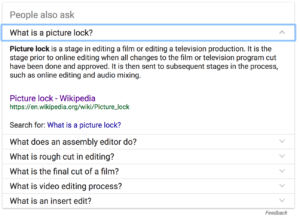Many years ago, I think I was maybe 24 or 25, I was walking a dog named Chloe and wondering how Jackson Pollack knew when his drip paintings were finished.

As I pondered, Chloe assumed her doggie poop position, dropped her load, and boom! It hit me. He knew instinctively, like Chloe knew when she finished doing her business — he felt it in his gut! Or maybe in his bones. Or maybe somewhere else, but he felt it.
Years later, when I started going to artist residencies and hanging out with painters I would ask them the same question. Most said something like, “When I see that I’m not improving the painting with more brushstrokes,” which ultimately comes down to it’s done when I feel like I cannot improve it.
And so, it is with great pleasure that I am announcing that A Life’s Work is done. Mostly. I have spoken those two scary words, “picture lock” and have given my digital files to the color corrector and the sound mixer. This means there will be no more shooting and there will be no more editing.
I qualified with “mostly” because the music is still being worked on and the credits need to be tackled. But essentially, it is done. And it is done because I feel there is nothing more I can do to it to make it better.
This feeling of done-ness was validated when I showed the film to cinematographers, Andy Bowley and Wolfgang Held, each of whom shot about 44% of the film. They weighed in with specific suggestions, terrific suggestions, most of which I took because I knew they would improve the film. I don’t want to say they were small suggestions, because they weren’t, but they weren’t big structural changes. They were changes or additions that were simple to do — put music here, think about removing that shot, things like that. Their few focused, excellent comments told me they thought the film was done, too.
And so, now to finish up the music.
Coincidentally, the day I completed this blog post, I listened to a Malcolm Gladwell podcast called Hallelujah, having no idea what it was about. From his Revisionist History site: “‘Hallelujah‘ is about the role that time and iteration play in the production of genius, and how some of the most memorable works of art had modest and undistinguished births.” It uses as its example an obscure Elvis Costello, Cezanne’s paintings, and the often covered song by Leonard Cohen.
As always, thanks for reading. And if you have the time and desire, leave a comment, I love hearing from you.
[stextbox id="alert"]Though the film is “done” it could still use your support for many things such as: paying the sound mixer, having the film made into a DCP file for festival screenings, closed captioning, E&O insurance, legal fees, festival fees, and on and on. So if you’d care to help out, all you have to do click the button…
Donate Now!
… and enter the amount you want to contribute. $4,000 covers the immediate need to get the film in shape for the Sundance Film Festival application. Pretty exciting, right?
Click the button, that’s it. No login or registration required. Your contribution does not line my pocket; because the film is fiscally sponsored by the New York Foundation for the Arts, all money given this way is overseen by them and is guaranteed to go toward the completion of this film. Being fiscally sponsored also means that your contribution is tax-deductible. So why not do it? You can give as little as $5 and as much as $50,000. And to be honest, I would rather have 800 people contribute $5 each than one person write a $4,000 check.
[/stextbox]


Judith Vogelsang
Terrific news! Congratulations! Looking forward to the final version.
David Licata
Thanks, Judith!
Joel
Huge congrats. Look forward to hearing more in person when I get back to town.
Best always,
Joel
David Licata
I look forward to that!
Bill Heffner
Great news!
David Licata
Thanks, Bill! I’m excited and terrified.